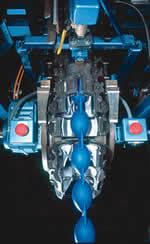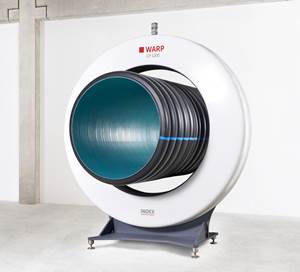Extrusion at NPE 2003
NPE is typically a competitive display of the biggest, most dramatic equipment machine builders can muster.
NPE is typically a competitive display of the biggest, most dramatic equipment machine builders can muster. This NPE, however, isn’t about bigness, and you probably won’t kick as many tires as usual. But that doesn’t mean there isn’t lots of new technology to see.
A couple of enhancements can make quantum differences in processes and products. Most of the new developments are intended to enhance output of machines that are already pretty advanced. A few new products are designed to make ancient extrusion lines work better. You’ll find improvements that apply to every aspect of an extrusion line, up- and downstream—dies, tooling, controls, motors, calibrators, coolers, cutters, and winders.
Many big machine suppliers are also showing new expert services, making a lot of industry talent accessible right at the show. So processors should come prepared with samples to test and questions to ask because there will be plenty of industry experts to answer you—for free.
Extrusion versus blow molding
The most dramatic extrusion novelty at NPE is probably Cullom’s revolutionary Convac tooling concept for corrugators (or indeed any large pipe extruder). The Convac System makes a chain of discrete hollow parts instead of continuous corrugated pipe. In principle, it works like a wheel blow molding machine except that the tooling doesn’t move on a wheel, but on the continuous loop of corrugator tooling track. As the profile is extruded, it’s pulled into the closing molds with suction and pinched off to form hollow parts. The Convac System, which has been used commercially for several years, actually leaves less pinch-off waste than blow molding, Cullom says. The firm will extrude mini coex footballs to give away at NPE; they will have a Santoprene TPV outer layer and PP inside.
Profiles chill out
To raise output of PVC profiles, Material Enhancement International is showing three emerging cryogenic technologies: 1) an internal profile cooling system that introduces chilled nitrogen gas inside the profile; 2) a cryogenic calibrator; and 3) a cryogenic cooling tank. There are several commercial installations of the cryo-cooling tank and one of the new cryo-calibrator. The company says PVC profile production can be three to four times higher with nitrogen cooling—if the extruder, die, and downstream equipment can handle that speed.
Getting more profiles out of one die also raises output. Catch a video from German profile die maker A&G, showing a six-strand PVC die. Downstream advances in tube-winding speed are shown by Boston Matthews and Corelco, both with automatic loading and unloading devices that let reels run continuously at very high line speeds, even during reel changes.
In pipe dies, Maillefer will show a five-layer coex die head for barrier automotive tubing. Maillefer has already designed one for six layers.
Pipe Coil Technology is displaying a new pipe/profile cutter, called Clean Cut, which can be programmed to cut specific numbers of different lengths of profiles.
Many profile displays involve wood- and fiber-reinforced profiles. NFM Welding Engineers touts the ability of its WE series of counter-rotating, intermeshing twin-screw extruders to maintain fiber length in long-fiber extrusion. NFM’s single-screw and corotating twin-screw lines target wood-composite profiles.
For fences and other profiles that require rework, Specialty Extrusion Equipment Inc. is adding flexibility to its traveling table saws, which typically saw, cut, and punch at the same time, but can now rout and mill too. That makes for higher output, lower cost, and better cuts because the plastic is warmer.
Thickness gauges shown at NPE also work faster than ever. On Line Controls is showing an ultrasonic thickness gauge that measures up to four times faster than it did before.
Expanding interest in polyolefin foams
Leistritz will conduct what is believed to be the first show demo ever of polyolefin foaming with supercritical CO2 on one corotating twin-screw extruder. Meanwhile, Davis-Standard will have a static display of a coex PE foam line using a counter-rotating twin-screw extruder, special two-layer die from Sentinel Products, and butane or CO2 blowing agent. A new screw boosts outputs of PE foam from the former 900-lb/hr rate up to 1400 lb/hr.
Sentinel is displaying unusual PP foam products at its booth, including developmental three- and five-layer sheets with a foam core and rigid skins. Sentinel uses an annular die and 4:1 blow-up ratio to orient the rigid skins so the bubbles don’t collapse. The resulting thermoformable sheet is surprisingly stiff, Sentinel says, and doesn’t sag in thermoforming ovens. Sentinel will license its process and die technology for packaging applications and use it in-house to make automotive products.
Safer roll stacks
NPE will display many new chill-roll stacks for sheet and cast film, all complying with new ANSI safety standards for fast emergency opening. Cooling rolls are also getting bigger to raise output. Welex’s new Evolution sheet line is redesigned with the extruder set higher to allow for bigger chill rolls—and for easier die cleaning.
News in flat dies includes EDI’s unique combination of mechanical and thermal actuation in its new Autoflex VI-L gauge-profiling die, said to be useful for controlling light-gauge sheet.
Davis-Standard will demonstrate its developmental wireless data-collection system on a lab-size cast film line. Though high-tech, it’s designed as a retrofit for older machines or for plants where layout or distances make hard-wired data collection costly or difficult.
Blown film news
Nearly all the blown film displays in Chicago have three layers, reflecting a market shift from mono- to multi-layer converting films, using the extra layers to accomplish downgauging. (An exception is Lung Meng from Taiwan, bringing a five-layer line.) “A lot of traditional single-layer films are moving to three layers to help fend off imports,” explains Steve Engel, president of Kiefel Inc. “Any non-barrier film capacity being added nowadays is three-layer.”
Virtually all blown film equipment suppliers at the show are also running their latest auto-gauging air ring and/or auto-die systems. Most of them have upgraded color touchscreen controls. Brampton Engineering will show an unusual auto-die system called I-Flex, which is the only one that alters the die gap with mechanical rather than thermal actuators.
For air-ring novelty, check out the “binary dual-lip” (i.e., four-lip) air ring at Macro Engineering. The 2 x 2 is not new but has never been displayed before. It’s for high outputs on dedicated lines. As for thickness gauges, Kundig is introducing to North America the model KNC-200—reportedly the only non-contact capacitance gauge on the market. Automation & Control Technology claims to have the first backscatter device that uses x-ray transmission instead of nuclear.
Virtually every major supplier of blown film lines is also showing new high-speed winders, many of them built for bigger roll diameters. Addex’s new SuperWind stacked winder, for example, makes up to 58-in. rolls, said to be a record for a stacked winder.
The new service sector
Black Clawson, ExtrusionTek Milacron, and several smaller suppliers are rolling out new “expert” services at the show. In part, they reflect a pool of talent available because of business slowdowns. Milacron’s services are available to existing customers or to “potential customers.” Black Clawson’s BC Encompass program is open to any processor. It focuses on optimizing cast film, extrusion coating, coating and drying, and flexible packaging processes. The program offers 24/7 global emergency services (including replacement parts), as well as field service, equipment upgrades, engineering services, and R&D. The program starts with a plant audit, which Black Clawson staff performs for $995 plus expenses, giving a report with suggestions to improve maintenance and overall line capabilities. The cost of the audit, except expenses, is refundable if the processor orders equipment from Black Clawson as a result of the audit.
ExtrusonTek Milacron’s ACES (application consulting engineers) are a newly assembled team of about a dozen specialist advisors. Some are Milacron employees, others are outside experts under contract for support work with customers on processing and screw-design issues. They include well-known names like James Frankland, ex-president of Newcastle; Jim Griggs, who developed dual-manifold dies for Mastic/Alcoa and spent 20+ years in siding and pipe extrusion at Mastic; and Ernst Krueger, former managing director of CPM, which Milacron acquired.
Related Content
Green’s the Theme in Extrusion/Compounding
The drive toward circular economy is requiring processors to make more use of PCR. Machine builders at K—across all extrusion processes—will be highlighting innovations to help them do just that.
Read MoreRadar-Based Wall-Thickness Sensor
Measurement units include an array of these sensors positioned around the circumference of the pipe, which can be placed in multiple locations on an extrusion line.
Read MoreHow to Effectively Reduce Costs with Smart Auxiliaries Technology
As drying, blending and conveying technologies grow more sophisticated, they offer processors great opportunities to reduce cost through better energy efficiency, smaller equipment footprints, reduced scrap and quicker changeovers. Increased throughput and better utilization of primary processing equipment and manpower are the results.
Read MoreOnline X-Ray Inspection Boosts Extrusion Quality
Höhle uses Sikora’s x-ray measuring systems for inline quality control of extruded microducts.
Read MoreRead Next
Troubleshooting Screw and Barrel Wear in Extrusion
Extruder screws and barrels will wear over time. If you are seeing a reduction in specific rate and higher discharge temperatures, wear is the likely culprit.
Read MoreUnderstanding Melting in Single-Screw Extruders
You can better visualize the melting process by “flipping” the observation point so that the barrel appears to be turning clockwise around a stationary screw.
Read More





























